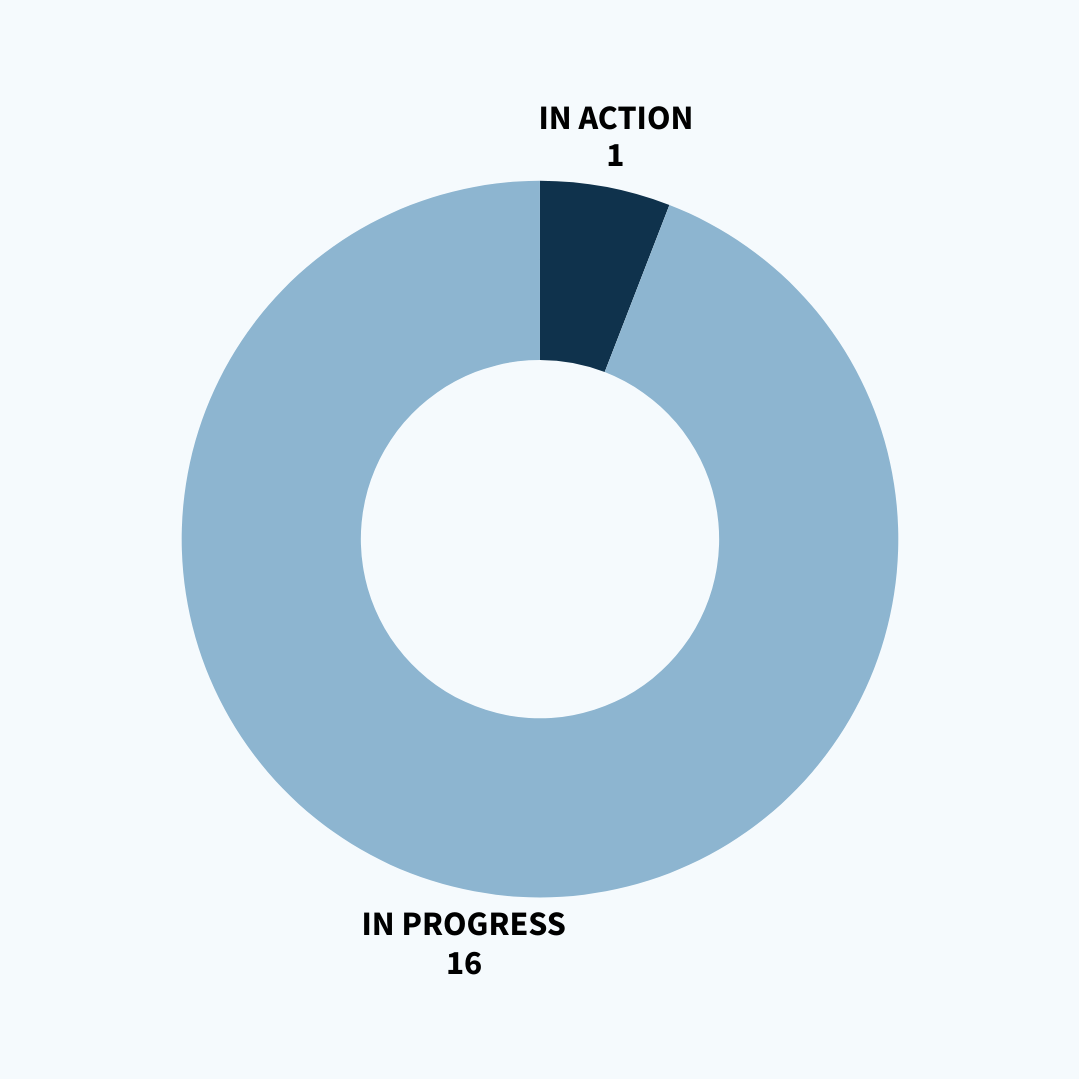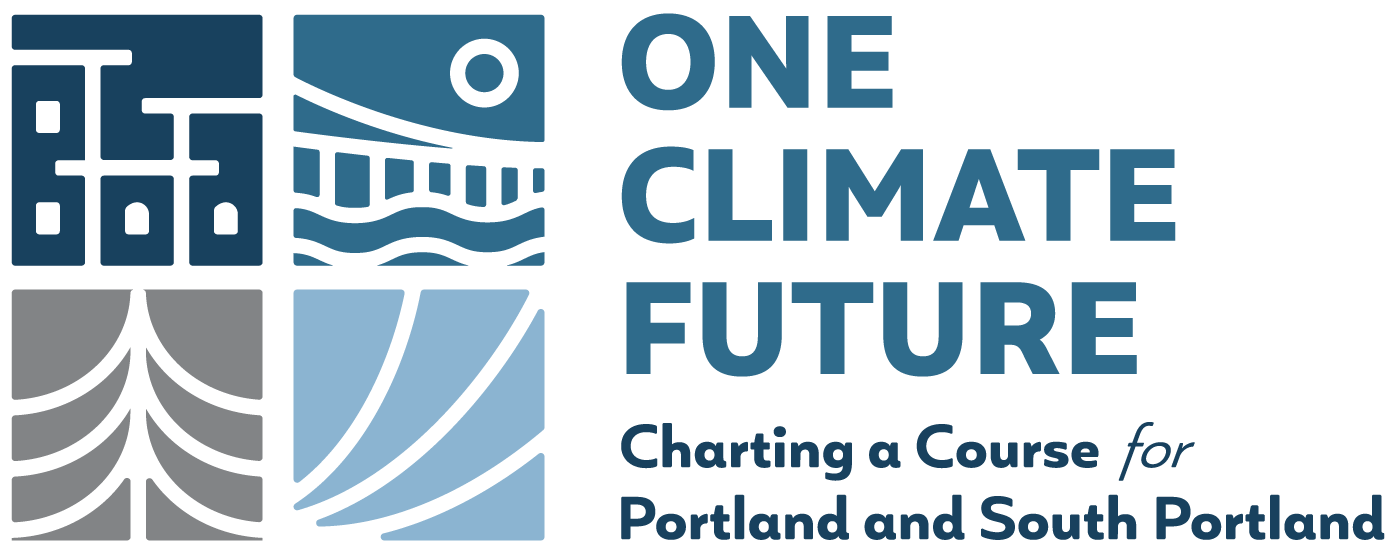Portland Progress

CLIMATE RESILIENCE
16 IN PROGRESS
1 NOT STARTED
(updated January 2025)

Integrate resilience standards and targets into Portland and South Portland’s land use code to minimize flood risk and promote resilient buildings and neighborhoods citywide.
Status: In Action
Update: Completed dynamic coastal flood inundation modeling for Portland in collaboration with U.S. Army Corps of Engineers, FEMA, NOAA, USDA, USGS, and Maine ACFD (2021). Adopted new Coastal Flood Resilience Overlay Zone in areas of future flooding as shown in the hydrodynamic model, with requirements that vulnerable first floor uses be elevated. Also adopted new low-impact development standards within the Technical Manual, for use in cases of new and re-development (2024).
Transformative potential: Regenerative, resilient
Key Milestones: No new incompatible, vulnerable, or hazardous uses built in areas of highest flood risk by 2026 (with adoption of resilience overlays)
Build knowledge, tools, and resources on climate risks and adaptation options for buildings and property.
Status: In Progress
Update: Published results of the coastal flood inundation model on a public mapping interface (2024). Fostering knowledge-sharing and resource development between City departments.
Transformative potential: Resilient
Key Milestones: All city residents have access to tools to assess future flood risk to property by 2026; Maine real estate flood risk disclosure required by 2026
Establish open space climate resilience goals and protocols for monitoring progress towards those goals in Portland and South Portland’s open space planning.
Status: In Progress
Update: Pursuing funding for a Tree Canopy Master Plan. (updated January 2025)
Transformative potential: Regenerative, resilient
Key Milestones: Benchmark ecosystem and resilience metrics for open spaces and establish performance goals by 2028
Continue to expand access to resilient and energy efficient affordable housing, contributing to diverse and inclusive communities.
Status: In Progress
Update: State adopted LD1656 “An Act to Promote Energy Efficient Affordable Housing” requiring construction projects funded by the Maine Housing Authority to meet certain energy performance standards, including full electrification of the systems used for heating, cooling, domestic hot water, and cooking (2022).
2023 projects that have received financial assistance from the City of Portland and therefore are required to comply with the City’s Green Building Ordinance include affordable rental housing developments at 200 Valley Street (60 units), Portland Housing Authority’s Washington Gardens project at 577 Washington Avenue (100 units), 73 Winter Street (43 units), 91 Winter Street (52 units), 45 Dougherty (63 units), 25 Casco (54 units), 622 Auburn Street (72 units). In addition, two condominium projects at 104 Grant Street (23 units) and Dougherty Commons on Douglas Street (20 units). The Portland Housing Authority Washington Gardens project was a combination of new construction and rehabilitation, which enhanced the efficiency of existing affordable housing along with creating new, efficient units.
2024 projects awarded financial assistance from the City of Portland and therefore are required to comply with the City’s Green Building Ordinance include affordable rental housing developments include Portland Housing Authority’s Riverton Park (182 units); this project is a combination of new construction and rehabilitation, which will enhance the efficiency of existing affordable housing along with creating new, efficient units. Other projects receiving funding awards in 2024 include 186 Woodford (43 units, 202 Woodford (45 units), Portland Housing Authority’s COMB Block Project at 70 E Oxford (55 units), Youth and Family Outreach Resource HUB project at 337 Cumberland Avenue (60 units) and 42 Atlantic Street (30 units). Portland Housing Authority also secured Brownfields funding to redevelop the Front Street community, transforming the area into a sustainable and affordable housing community. The new buildings are built to meet the rigorous Passive House standards for energy efficiency, the Department of Energy’s Zero Energy Ready Homes standards, and emphasize walkability and high-density development while preserving open space.
Continuing efforts to make energy efficiency upgrades and renewable energy options more affordable for all residents.
Transformative potential: Equitable, regenerative, resilient
Key Milestone: Increase housing units affordable to lower and middle income households by 10% by 2025 (from 2019 baseline)*
*Portland-specific milestone
Expand the “cooling capacity” of Portland and South Portland.
Status: In Progress
Update: Allocated $250k to expand tree canopy in Bayside neighborhood (2021). Planning for tree planting in progress. Portland Forestry Team and community partners planted 154 new trees as part of the Bayside Tree Project (2024). Revised site plan landscape standards to encourage canopy and large shade trees (2024).
Transformative potential: Equitable, regenerative, resilient
Key Milestone: All residents live within a half mile of a cooling center by 2035; all residents live within a half mile of a park or open space by 2035
Cultivate healthy, regenerative, and just food systems.
Status: In Progress
Update: Completed an urban agriculture plan (2021). Secured grant funding and began work to install soil barriers and raised beds at five recommended City community gardens: Boyd Street, Payson Park, Casco Bay, Common Share, and North Street. Completed Boyd Street, Payson Park (2024) and other rebuild events to transition all City community gardens to ADA-accessible raised beds.
Transformative potential: Equitable, regenerative, resilient
Key Milestone: Establish small grants for food system innovators by 2025; secure funding to commission foodshed assessment by 2028; expand access to community agriculture to all neighborhoods to meet demand
Continue to prioritize decision-making processes and transit investments that advance equity in our cities.
Status: In Progress
Update: Mid-term Strategy; Implemented Electrify Bikes! to offer an e-bike incentive program for low and moderate-income Portland residents (2023).
Transformative potential: Equitable, regenerative, resilient
Key Milestone: Address first round of proposals made by Community Transportation Leaders by 2026
Support and strengthen our existing community resources.
Status: In Progress
Update: Launched Sustainable Neighborhood Program to strengthen community resilience and encourage neighborhood-scale action (2023). Program achievements in 2024 include supporting seven community clean-ups, ten neighborhood block parties, and support to multiple community events (i.e., seed swap, cider pressing, music festival, winter neighborhood events, West End Tree Talks). Cohosted a Home Energy Efficiency Expo with an exhibit hall, presentations, and demonstrations from local home energy efficiency experts. Co-hosted four raised bed building workshops, bringing 100+ volunteer residents together to work collaboratively to build new raised garden beds in the City’s Community Garden Program. We will continue to support opportunities for relationship building among neighbors, and opportunities for residents to make an impact in their neighborhood, learn about City programs and other resources in the community, and feel empowered to be more active in the community.
Transformative potential: Equitable, regenerative, resilient
Key Milestone: Award the first round of community organizations or neighborhood groups with resilience grants by 2025
Create an ongoing platform for collaborative planning to ensure that Portland and South Portland’s port and waterfronts can respond, adapt, and thrive with new climate stresses.
Status: In Progress
Update: Continue to collaborate with the Waterfront Alliance as a platform for information sharing and dialogue on waterfront matters, including climate-related projects and issues. Harbor-wide dredge project underway (early 2025) including construction of a Confined Aquatic Disposal (CAD) cell serving the contaminated sediment disposal needs of both communities.
Transformative potential: Equitable, regenerative, resilient
Key Milestone: Grant funding and partnerships secured for resilient working waterfronts project by 2026
Attract, mentor, and build the skills of our cities’ workers to partake in quality jobs that help build a diverse, resilient, and regenerative economy.
Status: In Progress
Update: SMCC launched EV repair certification program (2021). Continue to promote skills courses and workforce training programs offered by Portland Adult Education, Evergreen Home Performance, Lift All Boats, Passivehaus, and more groups.
Transformative potential: Equitable, regenerative, resilient
Key Milestone: Targets set through the collaboration for net increases in individuals trained in specific sustainability and resilience fields
Build the capacity of the businesses and industries in our cities to bounce back, adapt, and innovate.
Status: In Progress
Update: Economic Development supported small businesses through a COVID hardship grant; COVID-related street closures made permanent to facilitate outdoor dining (2021). City of Portland with quasi-municipal partners are working to secure the future of the Portland Fish Exchange through State-funded infrastructure investments, program supports, and structural governance amendments to ensure a future for local fisheries and aquaculture businesses. Work has begun on a public/private partnership to construct a regional cold storage warehouse on Maine Port Authority property on the Portland Waterfront. The warehouse will improve local food manufacturing efficiency and will include the state’s largest roof-mounted solar array when completed in 2024.
Transformative potential: Regenerative, resilient
Key Milestone: Revise land use policies to reduce barriers to traditional and merging marine related industries by 2026
Use modeling and flood data to upgrade the Cities’ stormwater and sewer systems to handle future climate scenarios.
Status: In Progress
Update: Improvement of mapping/data for sewer and stormwater systems is currently ongoing; improvements to current hydrodynamic/operational flood modeling and coastal flood models continue as new data sources become available; continued improvements to SLR and Storm Surge Inundation mapping on an ongoing basis to understand parcel level and City-wide building/infrastructure impacts (2023). Development of the Coastal Resilience Overlay is underway due to the completion of the hydrodynamic model. The Coastal Resilience Overlay will continue to integrate future climate scenarios, sea level rise, and storm surge inundation mapping, as well as stormwater and sewer system upgrades. DPW has initiated steps to create a stormwater Capacity, Management, Operations and Maintenance (CMOM) program for its stormwater system. Long term goals of this program include creating system wide models of the City’s various separated stormwater systems. The first phase of this CMOM program development will include a comprehensive data gap analysis which should get underway in the spring of 2025. DPW is in the process of hiring a consultant to provide a major update and overhaul of the City’s existing India Street Pump Station combined Sewer SWMM model. The primary goal of this modeling effort is to help the City plan for future combined sewer overflow (CSO) projects aimed at reducing CSO’s into Portland Harbor. Updates to the model will consider future expansion and other uses such as flood adaptation planning. This modeling effort will commence in 2025 and take approximately 18 months to complete.
Transformative potential: Resilient
Key Milestone: Full geospatial data set completed for sewer and stormwater system by 2024; hydrologic/hydraulic drainage model completed by 2028
Expand the use of green infrastructure systems to capture and infiltrate the first inch of stormwater in any storm.
Status: In Progress
Update: Long-term Strategy; Portland has installed and currently maintains 204 publicly-owned green stormwater infrastructure systems; these systems include soil filters, tree well filters, bioretention cells, gravel wetlands, and porous pavement areas that help manage stormwater runoff in portions of the City served by either the combined sewer or storm drain systems. In 2024, 8 bio-retention cells (Rain Gardens) were constructed along the Western Promenade Road and on Forest Avenue to provide stormwater runoff treatment for approximately 0.5 acres of impervious land cover. The Water Resources has recieved funding as part of the FY24 operating budget to initiate the development of a green infrastructure design manual. DPW plans to initiate an RFP for this work sometime in 2025. Over the last 2 years DPW has worked closely with the Planning Department to update the City’s stormwater management regulations for development and redevelopment projects. The new standards were approved by the Planning Board on December 10th, 2024. The updated standard will increase the water quality treatment % requirement for a project’s non-roof redeveloped impervious areas from 50% to 95% for Urban infill redevelopment projects. The goal is to increase % of driveway and parking lot impervious areas being treated with green infrastructure as part of site development/redevelopment. The new standard also includes a minimum detention volume requirement that will require most development and redevelopment projects in Portland to retain, detain or infiltrate the first 1” of stormwater runoff on-site in an effort to help improve capacity and climate resilience within the City’s storm – sewer system over time. These updated standards will help the City meet two key goals of the OCF plans; increasing % of the impervious areas being managed by Green Stormwater Infrastructure systems over time and to require that new and redevelopment projects manage the first 1” of stormwater on-site. . As of late 2024 DPW is in the process of creating a geodatabase to track public and private green infrastructure and stormwater storage progress City wide. This database will help DPW manage its stormwater program and help track progress towards meeting green infrastructure goals set forth in OCF. The City is also in the design phase for a project that will retrofit an existing stormwater detention basin located on Palmer Avenue into a gravel wetland system aimed at meeting current day Maine DEP stormwater treatment design standards. Upon project completion, this system will provide stormwater runoff treatment for 33 acres of developed area and 12 acres of impervious area which currently flows untreated into Dole Brook. This project is anticipated to be bid in the spring of 2025 and complete construction by July 1, 2026.
Transformative potential: Regenerative, resilient
Key Milestone: 5% of the cities’ impervious surfaces converted to green infrastructure by 2035; 10% by 2040; and 15% by 2050
Build Portland and South Portland’s energy resilience.
Status: Not Started
Update: Mid-term Strategy
Transformative potential: Equitable, regenerative, resilient
Key Milestone: Development of Resilient Power Plan by 2026; all new development over 500,000 square feet to evaluate district energy/microgrids starting within one year of microgrid enabling legislation
Adopt a risk-based transportation asset management approach.
Status: In Progress
Update: Mid-term Strategy; Forming a working group to create a more explicit protocol related to transportation assets and climate resiliency (2023); currently taking advantage of certain projects to aid in resiliency such as:
- Washington Avenue Streetscape: Construction of infiltration devices in expanded sidewalk areas to take advantage of subsurface sandy conditions and reduce stormwater flow to water-resource assets.
- USM Roundabout: Intersection design to reduce vehicle idling and delays to lessen carbon emissions from ICE-based vehicles. Integration of rain gardens to allow for on-site retention and reduce peak stormwater flow to water-resource assets.
- Libbytown Two-Way Conversion (Active MaineDOT Connecting Communities and Neighborhoods Application): Convert Congress Street to two-way to allow for intown transportation access during storm events that flood Park Avenue.
- Franklin Plan Update: Exploring the potential to adjust the elevation of Franklin from Somerset Street to Marginal Way to reduce impact from major storm events and flooding of Bayside.
Transformative potential: Resilient
Key Milestone: Climate hazards and resilience indicators applied to all asset management decision-making by 2028
Strengthen ecosystem resilience through enhancing connectivity, biodiversity, and healthy habitat.
Status: In Progress
Update: Adopted amendments to the Pesticide Ordinance to include restrictions on synthetic fertilizers to take into effect spring 2023 under the Landcare Ordinance (2022). Continue to monitor invasive pests and enforce Landcare Ordinance.
Transformative potential: Resilient
Key Milestone: Fertilizer ordinance adopted by 2022; No net coastal wetland loss by 2035; establish biodiversity and connectivity targets by 2028
Build back the health of our soils for ecological vitality, water infiltration, and carbon sequestration.
Status: In Progress
Update: Adopted soil standards for new development (2021). Portland Parks, Recreation, and Facilities Department converted all fall leaf operations to entirely mulching in place (2022).
Transformative potential: Regenerative, resilient
Key Milestone: Post-construction soil health standards adopted for new construction or major renovations by 2025; “100 Resilient Yards” achieved in each city by 2028


